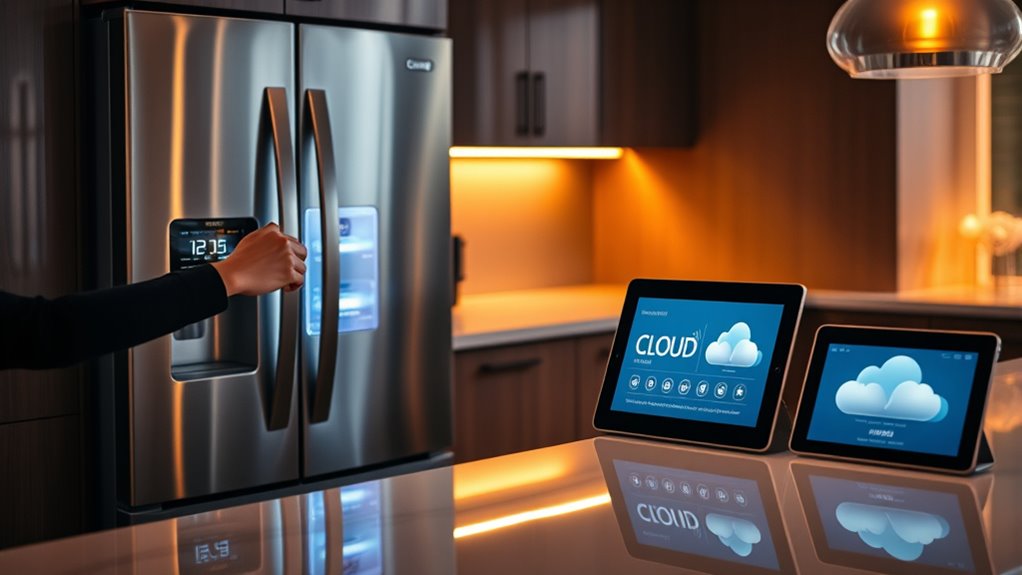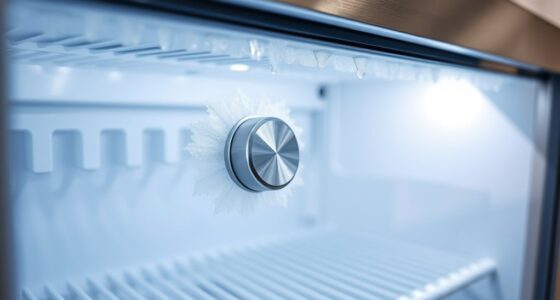If you rely on local control, your smart appliances respond faster, stay operational during internet outages, and keep your data private. Cloud control offers easier access and automatic updates but depends on a stable internet connection. Outages can block access and slow automation. Balancing these factors helps guarantee your smart home stays reliable. To discover more about how each method impacts your device’s dependability, keep exploring the key points.
Key Takeaways
- Local control provides faster response times and continuous operation during internet outages.
- Cloud control relies on internet connectivity, risking inaccessibility during disruptions.
- Local systems reduce dependency on third-party servers, enhancing reliability and security.
- Cloud-based appliances offer easier updates but depend on stable internet for consistent performance.
- Combining local and cloud control improves overall smart appliance resilience and operational reliability.
Dependence on Internet Connectivity
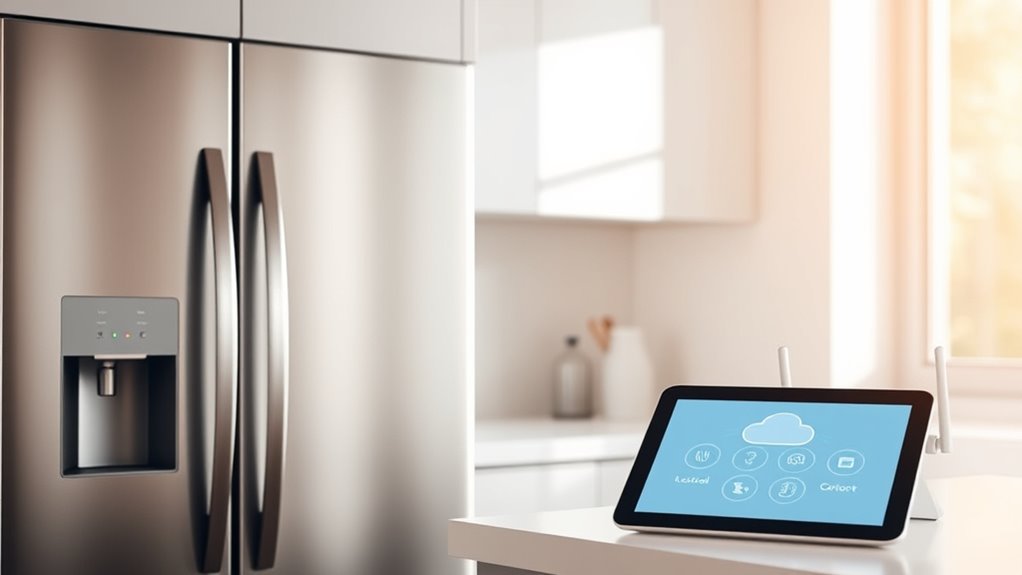
Smart appliances rely heavily on constant internet access to function properly, especially for remote control, software updates, and cloud-based features. Without reliable internet, you lose the ability to access doors remotely, view security camera feeds, or access cloud backups. Basic functions like status updates use minimal bandwidth, but multiple devices strain your network. Higher upload speeds (10 Mbps or more) are essential for cameras and video doorbells to work smoothly. When the internet goes out, these features become unavailable, and you can’t control devices remotely. Relying on a single internet connection creates a single point of failure, risking complete smart home functionality. To keep things running smoothly, you need a stable, high-speed connection that supports all your devices without lag or interruptions. Adequate bandwidth is crucial to ensure seamless operation of multiple smart devices simultaneously. Additionally, understanding the role of internet connectivity in maintaining device performance can help you plan for more resilient smart home setups.
System Resilience and Failure Points

When relying on internet connectivity for remote control and cloud-based features, the overall resilience of your smart appliance system becomes a key concern. Fault detection algorithms continuously monitor operation patterns, triggering alerts for anomalies and enabling rapid troubleshooting. Predictive maintenance, driven by sensor data, identifies potential failures early, reducing unexpected downtime. Automated power-cycling protocols help recover unresponsive devices remotely. Digital twins simulate scenarios, allowing proactive maintenance planning. Local control systems often include redundant hardware and fallback modes, maintaining operations during failures. Backup power sources, like uninterruptible supplies, ensure short-term operation during power glitches. Implementing robust security measures is essential to protect systems from cyber threats that could compromise resilience. Additionally, system redundancy and failover mechanisms are vital for maintaining continuous operation during unexpected disruptions. Combining local and cloud controls enhances resilience by balancing independence with scalability, especially when system resilience strategies are integrated into the design.
Response Time and Automation Speed
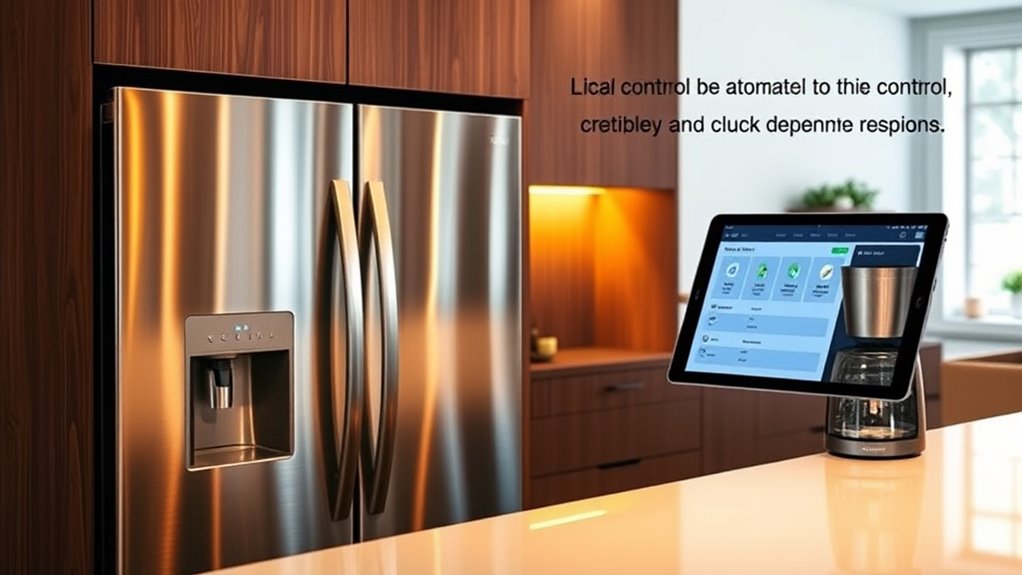
Local control systems typically respond faster than cloud-based ones because they don’t rely on internet connections or remote servers. This reduces delays caused by internet speed, server processing, and network congestion. For example, local voice commands often respond in about 3.89 seconds, compared to 5.21 seconds for cloud-based systems—about 25% faster. Local automation runs directly on the hub or device, minimizing latency and enabling near-instant responses. Protocols like Zigbee or Z-Wave further cut delays by facilitating direct device-to-device communication. Cloud automation, meanwhile, faces delays during peak usage or internet fluctuations, as requests queue on remote servers. During network outages, cloud systems can become unresponsive, while local control maintains consistent, reliable automation speeds independent of internet stability. Additionally, appliance testing and compatibility are crucial for ensuring safe and efficient operation of smart devices within local networks. This reliability is especially important for critical applications where prompt response times are essential.
Data Security and Privacy Considerations

Data security and privacy are essential considerations when choosing how to control your appliances. With local control, you own your data outright, stored directly on your devices, reducing third-party access risks. In contrast, cloud control shifts some trust to service providers, requiring confidence in their security measures and privacy compliance. Local systems can limit external sharing by design, but cloud systems may involve data sharing with third parties or for feature enhancements. Encryption plays an important role: cloud platforms use enterprise-grade encryption and multi-factor authentication to protect data during transmission and storage, while local systems depend on user setup, which can be vulnerable if poorly configured. Additionally, understanding data sovereignty is important, as it affects where your data is stored and the applicable legal protections. Moreover, the increasing integration of AI in devices raises concerns about the potential for unauthorized data access, emphasizing the need for robust security protocols. Ultimately, your choice impacts how much control, security, and privacy you maintain over your appliance data.
Access and Control During Outages

Power outages can disrupt the operation of smart appliances, but understanding how they function during these times allows you to maintain control. If you have backup power sources like generators or battery systems, your smart devices can continue functioning smoothly. Standby generators can automatically restore power, supporting your smart home’s core functions. Portable backup units, such as battery packs, keep critical devices running locally. However, internet connectivity is vital for cloud-based devices; without it, many won’t work. Smart home routines can be preconfigured to respond during outages, ensuring some level of control. To visualize, consider:
- Backup power sources keeping devices online
- Generators restoring whole-home power automatically
- Battery systems sustaining essential appliances
- Cloud-dependent devices becoming inaccessible without internet
- AI-powered systems are increasingly integrated into smart homes, highlighting the importance of reliable control during outages.
Balancing Features With Reliability
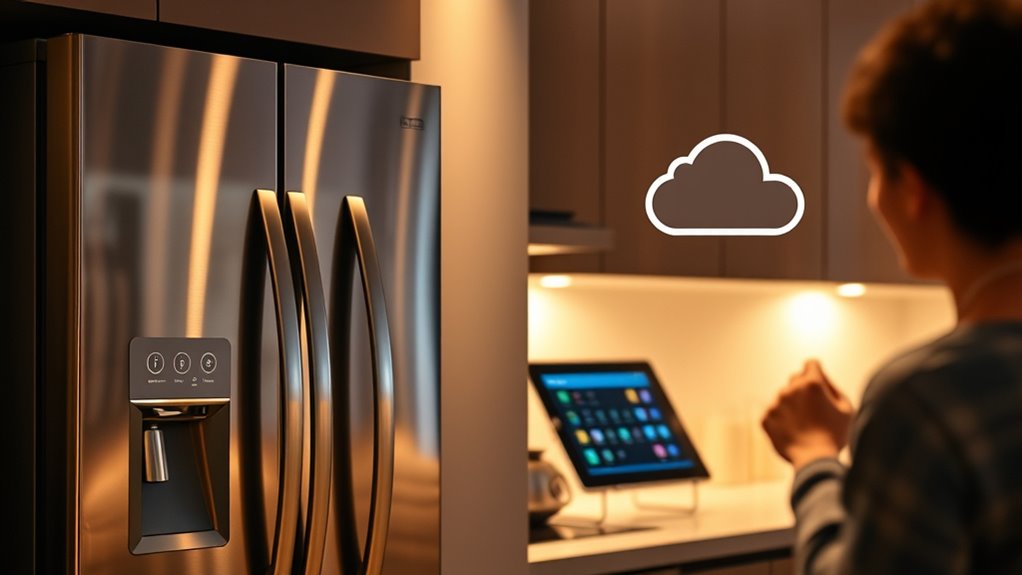
Balancing features with reliability means considering how much you depend on cloud services for access and advanced functions. While cloud control offers more capabilities, it also introduces risks if internet connections fail. Sometimes, sticking with local control guarantees your appliance runs smoothly even during outages, but it might limit your options. Incorporating sensor technology can enhance reliability by enabling devices to operate effectively without constant internet connectivity. Additionally, understanding aura and energy dynamics can help in assessing the overall health and functionality of smart appliances.
Feature Access Dependence
Smart appliances often rely heavily on internet connectivity and advanced software features to deliver enhanced convenience and customization. This dependence means that when your connection drops, many smart functions become limited or disabled, reverting to basic operations. Features like remote control, voice commands, and real-time diagnostics require stable online access. Loss of connectivity can prevent software updates, restrict AI-driven optimizations, and hinder feature evolution. Additionally, complex features involving sensors or cloud-based processing increase repair complexity and costs. Privacy concerns also influence feature usage, as data collection and sharing can pose risks. Compatibility issues with other devices or networks can further restrict feature access. Overall, your appliance’s ability to adapt and perform depends heavily on consistent internet access and ongoing support. Moreover, vulnerabilities to security issues, such as hacking or data breaches, highlight the importance of robust AI security measures to protect user data and maintain reliable operation. Regular updates and software patches are essential to address emerging threats and ensure sustained reliability.
Reliability Trade-offs
Enhancing features in smart appliances often involves trade-offs that can impact their overall reliability. Using cheaper materials to cut costs may lead to more frequent repairs and early replacements, reducing durability. Balancing energy efficiency with performance can mean operating components at lower power, which might weaken responsiveness and longevity. Supply chain disruptions have caused redesigns and supplier switches, resulting in inconsistent component quality and increased failure rates. Energy-saving algorithms and low-power hardware sometimes limit the appliance’s ability to handle peak workloads, affecting reliability. Additionally, limited software support—often only five years—means appliances face security risks and functional issues as support ends, lowering long-term dependability. These trade-offs highlight how feature enhancements can compromise the durability and stability of smart appliances over time. Moreover, high-quality equipment can significantly improve overall reliability and performance, but it often comes at a higher initial cost. Recognizing these reliability trade-offs is essential for consumers seeking long-lasting smart home solutions.
Frequently Asked Questions
Can Local Control Systems Be Integrated With Cloud Services?
Yes, you can integrate local control systems with cloud services. This hybrid setup allows your devices to operate locally during internet outages, maintaining essential functions. The cloud adds benefits like remote access, data analysis, and device interoperability across platforms. By combining both, you get a reliable system that stays operational offline while still enjoying the advantages of cloud connectivity for management, updates, and enhanced automation.
How Do Updates Differ Between Local and Cloud-Based Smart Home Devices?
Updates in local smart home devices are managed manually or through local protocols, giving you control over timing and minimizing disruptions. Cloud-based devices receive automatic updates pushed remotely, often seamlessly, but depend on internet stability. While cloud updates ensure you get new features and patches quickly, they can cause temporary outages or delays if your connection drops. With local updates, you stay in charge, keeping your devices current without relying on external servers.
Is Hybrid Control More Cost-Effective Than Purely Local or Cloud Options?
You’ll find hybrid control often offers better value than sticking to just local or cloud options. It balances upfront costs with ongoing expenses, letting you enjoy energy savings and flexibility. You can upgrade gradually, avoiding big surprises or obsolescence. Plus, it keeps your appliances running smoothly during internet hiccups. Overall, hybrid systems give you a smart mix of cost-efficiency, reliability, and future-proofing that makes your investment worthwhile.
What Are the Energy Consumption Differences Between Local and Cloud Systems?
You’ll find that local systems use less energy overall compared to cloud setups. Local processing consumes about 0.5 kWh per GB, while cloud processing and data transmission can reach around 2.2 kWh per GB. By keeping data on-site, you reduce transmission energy and reliance on cloud servers. Hybrid systems strike a balance, saving roughly 65% of energy compared to full cloud solutions, making them more efficient and eco-friendly.
How Do Firmware Updates Impact Device Performance and Security?
Firmware updates can considerably boost your device’s performance and security. They optimize operation, add new features, and fix bugs, making your appliances run smoother and last longer. Plus, updates patch security vulnerabilities, protecting your data from cyber threats. Without them, your devices become more prone to malfunctions and cyberattacks. Staying current with firmware updates ensures your smart appliances stay reliable, secure, and capable of serving you well for years to come.
Conclusion
Choosing between local and cloud control is like balancing reliability with convenience. While cloud offers remote access and advanced features, it depends on internet stability—leaving you vulnerable during outages. Local control may lack some bells and whistles but keeps your appliances running smoothly when connectivity drops. Ultimately, it’s about weighing seamless automation against dependable performance. You get the best of both worlds when you find a system that’s resilient, secure, and tailored to your needs.
